
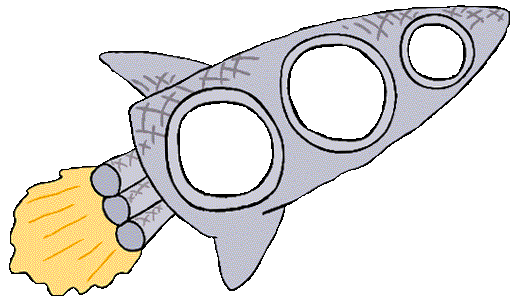
Asimov, I. "I, Robot" [Science Fiction Narrative]
Bloch, A. "Humans Are Different" [Science Fiction 1st Person Narrative]
Serling, R. "The Monsters Are Due on Maple Street" [Television script]
"Orbitville" [Poem]
New York Times Science News
Air and Space Exhibition, Smithsonian Institute, Washington, DC
Hayden Planetarium, New York City
Liberty Science Center, Liberty State Park, New Jersey
Franklin Science Institute of Technology, Philadelphia, PA
Museum of Natural History, Hall of the Planet Earth, New York City
![]()
Teacher's Aim: To read various poems, plays, and stories in order to understand the elements of science fiction as a distinct genre of literature.
To generate interest in reading science fiction.
Motivation: How are the Star Trek movies, Star Wars, Jurassic Park and Men in Black all alike?
Student's Aim: How can we identify science fiction? What are the elements of a science fiction story?
Procedure:
1. Motivation.
2. Teacher draws semantic web on board adding ideas students offer as they are engaged in the discussion.
3. Ask students to look over the notes written on the web. Pair students. Challenge them to write a definition of science fiction, using the ideas shared in class.
4. Turn pairs to foursomes. Ask students to share definitions. Synthesize the two definitions. Write on chart paper.
5. Group spokespersons read definitions.
6. Teacher reads information regarding definitions of science fiction from The Science Fiction Encyclopedia (Pages 159-161).
7. Present the Webster's definition: "Science fiction is fiction dealing principally with the impact of actual or imagined scientific development upon society of individuals; also, futuristic fiction using an aspect of science as an essential component of the plot."
8. Develop ELEMENTS OF SCIENCE FICTION Chart with class focusing on plot, setting, problem, and characters.
IDEAS
PLOT: The story contains events that may actually occur in the future, based on today's scientific knowledge.
SETTING: The story takes place in the near or distant future, either on Planet Earth, or in the place that scientists propose that we may some day colonize.
PROBLEM: The characters in the story might solve the problem using actual scientific data or knowledge.
CHARACTERS: The characters, although fictional, behave realistically, in ways that seem reasonable from a scientific point reasonable from a scientific point of view.
9. Students copy their class-created chart into notebooks.
Summary: How can we identify stories of science fiction?
Application: Why do people read and write science fiction? [Possible answers: free them from the limitations of the present; lead them to possibilities of the future world; stretch the imagination; consider ways of changing the future, etc.]
Homework:
1. Brainstorm a list of 10 science fiction stories and movies. Be sure each meets the criteria outlined in the definition and on the chart.
2. Select your favorite from the list. Explain how the author dealt with each of the elements of science fiction in the story.
Extra Credit:
1. Compare science fiction and fantasy -- two distinct genres often confused. Create a chart to show their differences and similarities. Be sure to use references to get information.
2. Research the work of authors H. G. Wells and Jules Verne who were important in the development of science fiction as a literary genre.
![]()
Teacher's Aim: To learn to recognize "point of view" as a literary device. To recognize the powerful effect the use of the first person narrator can have on the reader.
Motivation: Read an excerpt from "I, Robot" by Isaac Asimov. Ask: Whose point of view is being shared in the narration of this story? Why do authors sometimes use a character as the narrator of the story? Aim.
Students' Aim: Why do authors sometimes use a character as the narrator of the story?
Procedure:
1. Motivation.
2. Aim on board.
3. Discuss story excerpt. How was this use of first person narration an effective device? Describe the speaker's tone. Introduce the concept of 1st person point of view vs. 3rd person point of view.
4. Distribute texts [McDougal, Littell Literature, Red Level]. Introduce story: We are going to read another short story entitled: "Humans Are Different" written by contemporary science fiction writer Alan Block who was born in New York City. Many of his science fiction books and stories have won awards.
5. Teacher begins reading... Students are asked to complete the story to learn: "How humans are different?"
6. Ask students to write a reaction to the story in their reader response journals.
7. Have students share responses with groups.
8. Group-share discussion regarding both "robot" stories. Have spokespersons share responses to the reading afterward during the whole group debriefing.
9. How do these stories relate to the criteria outlined on our sci fi chart?
Summary: How is first person point of view effective in each of the readings? Why do authors use first person point of view in stories? [Elicit: Characters may easily explain how they are thinking; reader learns about the inter-most thoughts possessed by the character, etc.]
Application: How can recognizing the point of view of a story help you to be a better reader?
Homework: Find two (2) other stories in your literary anthology that
use the first person point of view as a literary device. Explain why the
author uses this technique in these stories.
![]()
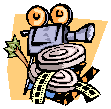
Teacher's
Aim: To read the Twilight Zone screenplay "The Monsters Came to Maple
Street" by Rod Serling to recognize point of view.
Motivation:
How many have seen the old TV show The Twilight Zone?
read stories by its creator Rod Serling?
Show a clip of the beginning of one of the episodes using the VCR...
Serling, the author, introduces the twilight zone... Aim.
Students'
Aim: What happened when the
monsters came to Maple Street.
Procedure:
1.
Motivation. Aim on board.
2.
Discuss. What is the twilight zone
according to Serling?... Introduce title of the play. Review special directions
written in the script concerning camera shots, etc.
3.
Give roles to students.
4.
Refer to the photograph in the book. What
is the setting of the story? When
does this story take place? How do you know from the photo?
Where might Maple Street be located?
Might it be a street in a Staten Island town?
5.
Read play.
6.
Discuss plot/problem. 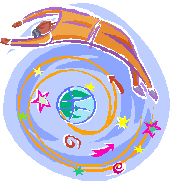
7.
Who created this havoc? From
whose point of view is the "moral" of the story presented?
Elicit: Aliens. Discuss.
8.
How did they turn the humans into enemies and vigilantes?
9.
Could this happen in the future? Discuss.
Summary:
Who were the monsters on Maple Street?
Application:
How does this story help us to understand humanity?
Homework:
Read the poem "Nighttime Visitors"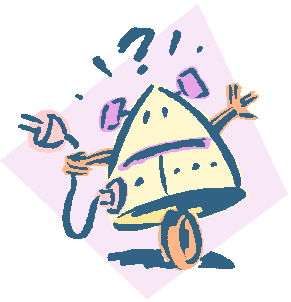
Who
is the speaker of the poem? What is
the speaker's problem? Whose point
of view is presented? How is point
of view important in this poem? Explain.
![]()
Teacher's
Aim: To facilitate students' research concerning trends, innovation and the
future using newspapers and periodicals.
Motivation:
Distribute a photocopy of a current news article and an advertisement with
innovative or dramatically new/different product or prototype.
Discuss implications.
Introduce
idea that the seeds of tomorrow are in today. Aim.
Students'
Aim: How are the seeds of tomorrow found in today's news?
Materials:
Future Boxes - contain 3 newspapers, 2 catalogs, and 4 magazines - including Scientific American, Time,
Newsweek, USA Today, Wall Street Journal, NY Times, and various
catalogs from Brookstone, Sharper Image, etc.
Procedure:
1.
Motivation.
2.
Aim.
3.
Distribute Future Boxes to groups with challenge sheets. 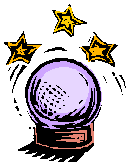
4.
Hands on activity described - Scan the materials in the Future Box to locate
seeds of tomorrow. Find ideas in 5
or more categories:
SPORTS
SCHOOL
ENTERTAINMENT
HEALTH
BUSINESS
HOME
FOOD
TRANSPORTATION
CLOTHING
5.
Explain how these "seeds" will grow into everyday trends of the
future.
6.
Groups share findings. Discuss.
Summary:
How
can we predict what our future world will be like?
Application:
Why is it important to think toward the future?
Homework:
1.
Write a response to today's activity in your journal.
2. Select one of the "seeds" you discovered today - explain how it will change your life?
![]()

Teacher's
Aim: To create a survey for the implementation of a Delphi study.
Motivation:
Read aloud current article re Nostradomus' predictions - show
books and articles on bulletin board relating to his thoughts about the
future and what has actually taken place. Discuss.
Write
on board: "The seeds of the
future are in today." How
would you like to know what the world will be like in 50 years?
Students'
Aim: To conduct a survey to discover people's predictions about the future.
Procedure:
1.
Motivation.
2.
Aim.
3.
Introduce Delphi Technique [Whaley,
Charles E., (1991) Enhancing Thinking & Creativity with Futures
Studies, New York: Trillium Press.]
4.
Select panel of experts. Prepare and send letter explaining the project.
5.
Send first round of questionnaires to panel.
6.
Analyze the results of the returned questionnaires.
7.
Based on the analysis prepare a second round of questionnaires.
8.
Send second round to the panel.
9.
Analyze the questionnaires.
10.
Prepare a report of the findings and/or conclusions.
Summary:
How will the Delphi Study help us to prepare for the future?
Homework:
On going - survey and interview community members re the future.
![]()
Teacher's
Aim: To engage students in a creative writing experience focused on the
genre of science fiction modeling great writers' works.
Motivation:
Bulletin Board with movie posters and stills from classic and contemporary
science fiction stories. Number the photos/posters. Books on display from popular authors including Arthur C.
Clarke, Isaac Asimov, Jules Verne, Rod Serling, etc.
Student
Aim: To create a science fiction story using the elements of the genre.
Procedure:
1.
Do Now. SCI FI CHALLENGE
Can
you name 5 of these stories depicted on the bulletin board? or are you lost in space?
2.
Motivation.
3.
Review elements of science fiction as a genre of literature.
Refer to chart.
4.
Distribute story frames. Model
outline of story frame used as skeletal outline for
teacher-written science fiction story.
5.
Writing workshop - allow 15 minutes.
6.
Share story ideas with partners who respond with positive comments.
7.
Whole class sharing concerning story ideas.
Summary:
How
is science fiction different from other fiction?
Homework:
1.
Explain how your story qualifies as science fiction. Be specific.
2.
Begin to write your story using descriptive language.
Refer to the Science Fiction Word List
in your notebook for ideas.
![]()
Teacher
Aim: To describe the City of the Future created on the computer [Sim
City 3000] in both written and oral presentation formats.
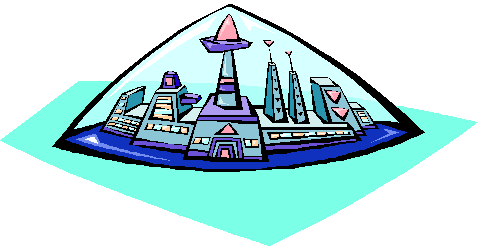
Motivation:
Inherent
in computer created activity. Visual
presentations enhance ability to write.
Student
Aim: To describe the City of
the Future created on the computer [Sim City
3000] in both written and oral presentation formats.
Procedure:
1.
View Future City created by students. Explain
need for the students to write a description of the City for the viewer.
2.
Offer students opportunity to write in one of the following formats:
a. Tour guide to the Future City.
b. Advertisement written to persuade visitors and potential community
members to visit the City and to relocate.
3.
Refer students to word list and thesaurus to build writing vocabulary.
4.
Students work through writing process steps: Brainstorming, Drafting, Editing,
Rewriting, Revising and Publishing.
5.
Student work is shared/displayed in conjunction with 3 Dimensional projects and
software designs.
Summary:
How does the written description of the Future City enhance viewers'
understanding of the design?
Homework:
Ongoing through writing process dependent upon individual's needs.
![]()
Teacher's
Aim: To research information
about important futurists in order to create an interactive multimedia
biographies about imagineers. To create interactive biographies with  Technology
Teacher.
Technology
Teacher.
Motivation: Read aloud Pop-up Book of Leonard DaVinci - Question students concerning futuristic thinking of this Renaissance thinker. Refer to books about Nostradamus, and other books by famous futurists including:
Introduce
multimedia interactive biography of Arthur C. Clarke... Invite students to
create imagineers' biographies. and to visit links for each of the imagineers.
Aim.
Students'
Aim: To research information
about important futurists in order to create an interactive multimedia
biographies about imagineers. To create interactive biographies with Technology
Teacher.
Procedure:
1.
Motivation.
2.
Aim.
3.
Students research using electronic software (in conjunction with technology
teacher).
4.
Give students lists of futurists to be included in our Biography of Imagineers.
5.
Students research using books, encyclopedia and electronic software (Internet,
if possible).
6.
Students design biographies using Inspiration Software to take notes and
outline.
7.
Students write short biographies of the imagineers' lives, works and predictions
about the future.
Summary:
How have imagineers played an important role in society?
Homework:
Ongoing research, notetaking, composing - individualized according to students'
progress through the unit. Final
product - written presentation of the report; HyperStudio presentation - two
stacks about the subject.
![]()
BUILDING
A FUTURISTIC
CITY - SIM
CITY 3000
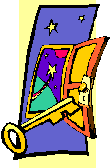
For possible inclusion:
Video
recordings of Futures Projects including:
Copies
of School Related Materials:
School
Newspaper
Yearbook
Literary
Magazine
History
of the School
Findings
of the Delphi Study
School
Pennants
Copies
of important ideas related to local, national and international affairs,
personalities, celebrations, and ideas.
Display futuristic cities, publish results of Delphi study in school publication, invite parents and staff to science fiction themed celebration, take trip to science museum to speak with scientist concerning the experience.